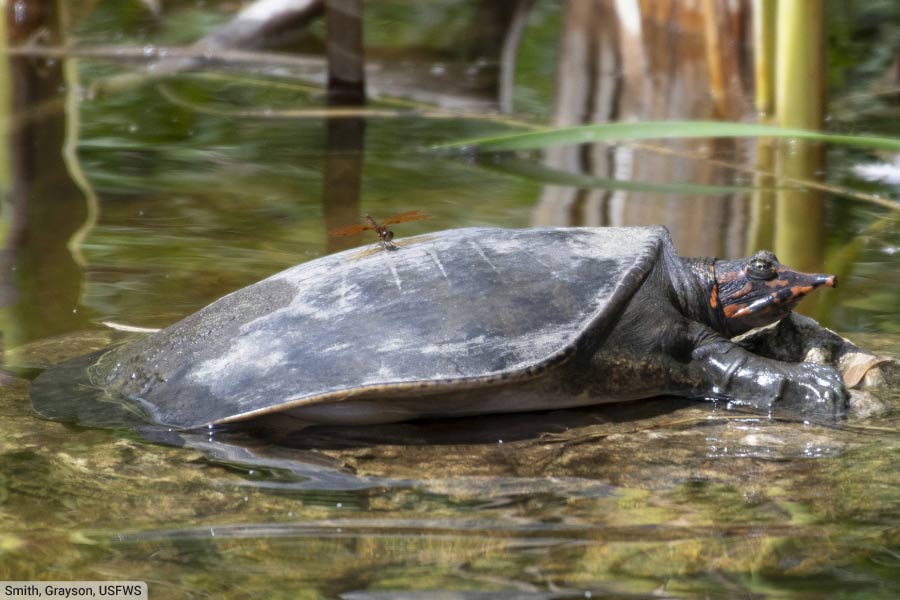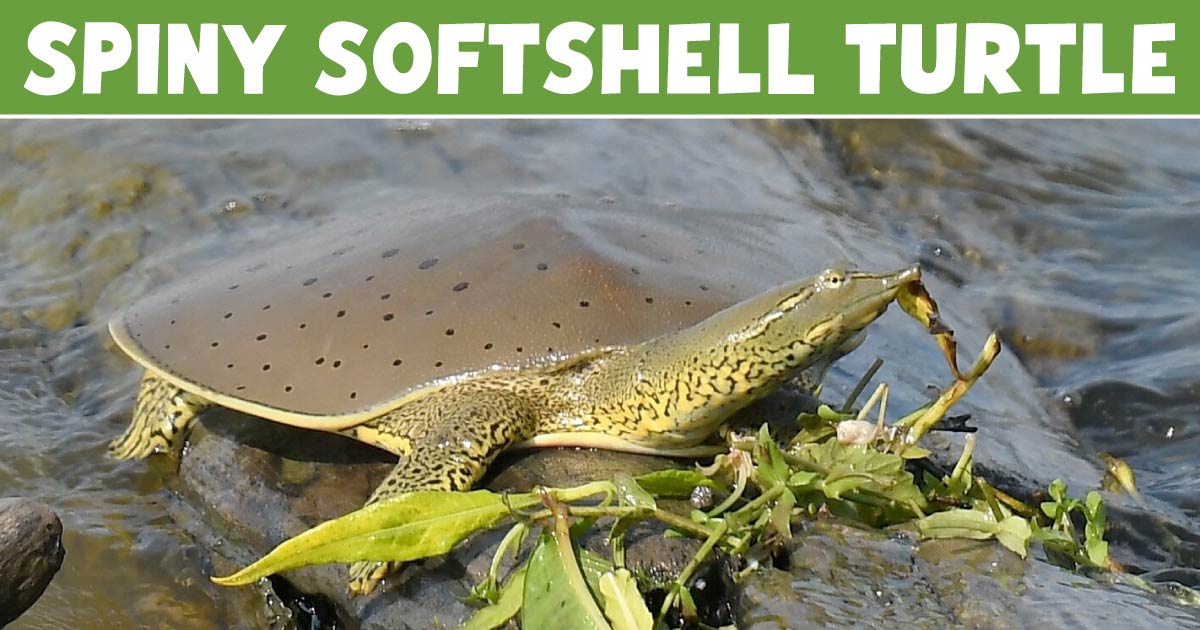The spiny softshell turtle is a freshwater turtle named for the short, blunt spines on the front of its soft, leathery shell.
Read on for a complete guide to this fascinating North American reptile…
Spiny Softshell Turtle Stats
- Scientific Name: Apalone spinifera
- Class: Reptilia (reptiles)
- Order: Testudines (turtles)
- Family: Trionychidae (softshell turtles)
- Length: Typically 0.3 to 0.5 meters (1 to 1.6 feet)
- Weight: Typically 4 to 6 kg (8.8 to 13.2 lb)
- Where Found: North America, from Canada to Mexico in freshwater rivers, streams, and lakes.
- IUCN Conservation Status: Least Concern
What is a Spiny Softshell Turtle?

The spiny softshell turtle is a North American member of the softshell turtle family, Trionychidae, named after the small, spine-like projections that adorn the front edge of its carapace (shell).
Like other softshell turtles, the spiny softshell has a soft, leathery carapace, enabling increased speed and maneuverability, both in and out of the water.
The spiny softshell turtle spends most of its life in the water, and is often found buried in the sediment, breathing via its long neck and long, snorkel-like nose.
The species is also able to breathe underwater, via the skin of its mouth cavity. This ability is useful during the cold months, when the turtle buries itself in the mud and enters a state of inactivity known as brumation (a condition seen in reptiles and amphibians similar to hibernation).
The spiny softshell turtle exhibits sexual dimorphism, with females being significantly larger than males (a trait common among members of the family Trionychidae).
A predator, the spiny softshell turtle uses its long, flexible neck and quick jaws to capture a variety of prey, including insects, crustaceans and fish.
Sexual dimorphism = differences in size, coloration, shape, or other physical characteristics between males and females of the same species.
What Does A Spiny Softshell Turtle Look Like?

The spiny softshell turtle possesses a distinctive pancake-flat, leathery carapace (shell) that lacks the typical scutes (hardened, bony plates) seen on most turtles. At the front edge of the carapace are the small, spine-like projections that give the turtle its name. These are most commonly seen on males.
Coloration ranges from olive to tan, often with dark spots or streaks that help in camouflage, and the pliable shell allows for more efficient swimming. The species’ color will often match that of its habitat.
The species has a long, tapered snout that functions almost like a snorkel, enabling the turtle to breathe while mostly submerged.

The limbs of the spiny softshell turtle are paddle-shaped with webbed feet, well-suited to its aquatic environment, and males generally have thicker and longer tails compared to the females. Females, however, are notably larger in overall size than males.
Where Is The Spiny Softshell Turtle Found?

The spiny softshell turtle is found throughout a wide range in North America. Its habitat ranges from southern Canada, throughout the United States, and into northern Mexico.
Habitat
The spiny softshell turtle is commonly found in freshwater environments such as rivers, lakes, streams, and ponds. It prefers waters with soft, sandy, or muddy bottoms where it can burrow for camouflage and search for food.
Diet
The spiny softshell turtle is primarily carnivorous, feeding on a variety of aquatic prey. Its diet includes fish, crustaceans, insects, mollusks and worms.
The species may also consume some aquatic vegetation and carrion. Its foraging strategy involves lying in wait, partially buried in the substrate of its aquatic habitat, and rapidly extending its neck to snatch prey with its long, tubular snout and sharp jaws.
Family And Related Species

The spiny softshell turtle is a member of the order Testudines, the group of reptiles that encompasses all turtles and tortoises.
The species belongs to the family Trionychidae, members of which are commonly known as softshell turtles due to their distinctive soft carapaces.
This family includes about 33 species (source-Catalogue of Life) spread across several genera, with the genus Apalone, to which the spiny softshell belongs, comprising three recognized species (source – Reptile Database).
The other species within this genus are the smooth softshell turtle (Apalone mutica) and the Florida softshell turtle (Apalone ferox). These species share similar habitats and ecological niches across North America and exhibit a variety of adaptations that allow them to thrive in aquatic environments.
Other members of the family Trionychidae are found in Africa, Asia, and North America.
Life Cycle & Lifespan
Mating occurs in the water, typically in spring or early summer. Female turtles lay their eggs on sandy or muddy banks, selecting sites with ample sunlight to incubate their eggs. They can lay anywhere from a few to several dozen eggs, which hatch after about 60 to 80 days, depending on the temperature.
The hatchlings emerge fully independent, making their way to the water where they are at high risk of predation. Those that survive infancy grow rapidly in their first few years of life. Sexual maturity is reached between 8 to 10 years for males and perhaps later for females due to their larger adult size.
The spiny softshell turtle has a long lifespan, potentially living up to 50 years in the wild. It continues to grow throughout its life, although the growth rate slows considerably with age.
In colder regions, the species goes through seasonal cycles of activity and brumation, a hibernation-like state seen in reptiles.
Is the Spiny Softshell Turtle Endangered?
The spiny softshell turtle has the IUCN conservation status of “Least Concern”, and therefore is not endangered. In some parts of its range, however, the species is threatened by overhunting, capture for the pet trade, and habitat loss.
Discover More With Active Wild
Visit our main animals page for links to animal information and a complete guide to the animal kingdom: Animals
Discover different types of turtles on this page: Types of Turtles
You can find out more about reptiles on this page: Reptiles – The Ultimate Guide
Discover different types of reptiles on this page: Types of Reptiles
You can see more North American animals on this page: North American Animals

